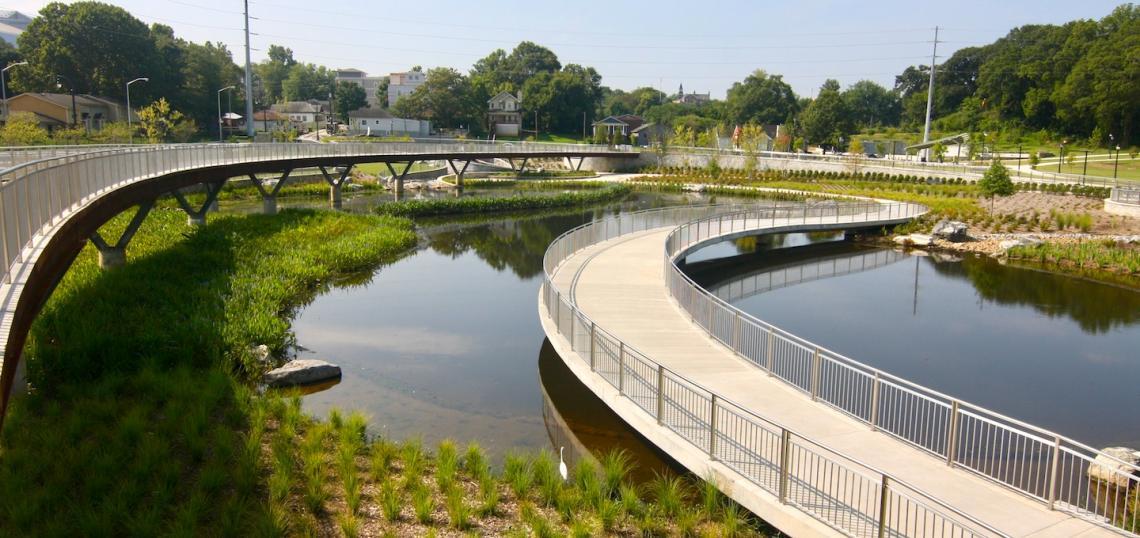As urbanist wonks who’ve been tracking this sort of thing know, leafy Atlanta has been mired for more than a decade in the middle of the pack when it comes to an annual ranking of park access in the largest 100 U.S. cities.
Those days, at least for now, are over.
But analysts acknowledge the City in a Forest isn’t exactly acing the parks test and remains hindered in specific, disconcerting areas.
First, the good news.
Following a monumental year in 2021 for new urban greenspaces—from sprawling Westside Park to functional, beautiful Cook Park in Vine City, and a park-topped parking garage in Grant Park, among others—Atlanta rocketed up 22 spots on the 2022 ParkScore Index, a ranking compiled by the Trust for Public Land.
That made Atlanta the biggest mover of the year, across the nation’s most populated 100 urban places.
 Westside Park's marquee attraction, a reservoir overlook toward the city. Josh Green/Urbanize Atlanta
Westside Park's marquee attraction, a reservoir overlook toward the city. Josh Green/Urbanize Atlanta
The less flattering news is that a metropolis known for trees, greenery, and natural (if understated) beauty is still bested by 26 other cities across the country.
Two major initiatives, Cook Park and Westside Park, were responsible for the bulk of Atlanta’s ParkScore rank increase. Alongside accessibility improvements, the new greenspaces boosted the number of Atlantans who live within a 10-minute walk of a park from 72 to 77 percent last year. Impressive.
With increases in park investment, the Trust for Public Land found that Atlanta now spends more than double the national ParkScore average on parks ($206 per person, versus $98).
Nonetheless, analysts found that Atlanta still barely exceeds the ParkScore average of 75-percent quick walking access.
“Atlanta’s ParkScore rank remains limited by its smaller average park size (2.9 acres, compared to the national average of 5.4) and below average marks on ParkScore’s park equity rating factors,” noted Trust for Public Land officials.
 Swooping bridges over Cook Park's flood-solving water feature in Vine City. Josh Green/Urbanize Atlanta
Swooping bridges over Cook Park's flood-solving water feature in Vine City. Josh Green/Urbanize Atlanta
Once again, Washington D.C. held the top ParkScore ranking, narrowly besting second-place finisher Saint Paul. Cincinnati jumped from 8th to 4th place simply by allowing residents to use its school playgrounds after hours and on weekends.
Behind Atlanta, the other top ParkScore movers this year were Honolulu (+14 to 43rd place), Baton Rouge (+11 to 67th), and Des Moines (+10 to 25th).
The study noted that relatively compact San Francisco and Boston are the only ParkScore cities where 100 percent of residents can walk to a public greenspace in 10 minutes or less. (If COVID-19 lockdowns didn’t teach us the importance of that, nothing will.)
City of Atlanta officials rallied around news of the big ParkScore leapfrogging this week, with Mayor Andre Dickens predicting that more climbing is to come with initiatives such as Lower Paul Park, the first city greenspace with direct access to the Chattahoochee River.
“I’m committed to making sure that every resident has access to our beautiful greenspaces—regardless of zip code,” Dickens said in a prepared statement. “While I’m proud of the work we’ve done to achieve this ranking, we’re not done yet… Make room for Atlanta at the top, where we belong.”
• Recent ATL parks and trails news, discussion (Urbanize Atlanta)







